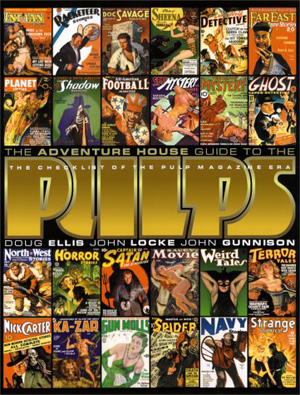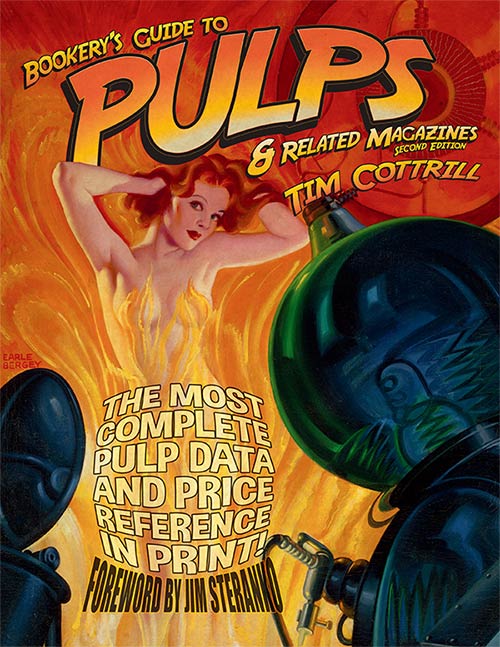Back? All right, keep in mind that i'm not trying to show his definition is broken; it's a working definition that helps a casual browser get a sense of what a pulp magazine is.
Before we start. I've tried to link every photo to an EBay listing, in case you feel the need to rush out and buy the thing. (Or verify my facts). With that said, let's do a quick recap of what David says:
Format
- A magazine, printed on low-quality, rough paper.
- Untrimmed edges with cover overhang.
- Page count from 128 to 192 pages.
- Size about 7x9 inches.
- With an illustrated cover.
- Staple bound.
- All fiction, possibly with illustrations for each story.
- May have a few pages of advertising.
- A magazine, printed on low-quality, rough paper
What happens to the (Love Story, Detective Story, Western Story) Annual issues from Street and Smith? Is yearly publication periodical enough? They did skip a few years, though - Western Story Annual was first published in 1941, no issue in 1942, 1 issue each year from 1943-1946 followed by 2 issues in 1948 and 1950. Does that qualify as a periodical? Doesn't it look like a pulp to you?
Western Story Annual 1944
Low quality, rough paper? This issue of Adventure, April 15, 1927 is printed entirely on book quality paper that still remains white after more than 90 years. (Ignore the brown stain at the bottom that we all hope is from an unknown beverage; the picture is from an EBay listing described as good condition for age)
- Untrimmed edges with cover overhang
Many other pulps were trimmed, among them fan favorite Unknown.
And The Shadow
- Page count from 128 to 192 pages
64 pages (All Detective November 1932)
224 pages for this issue of Short Stories dated May 25 1932
240 pages for this All-Story December 1913 issue (not for sale, alas)
320 pages for this truly monstrous Mammoth Detective from 1942
- Size about 7x9 inches
Digest size
Adventure July 1951
Bedsheet size
Argosy November 29 1941
Large size
Weird Tales March 1924
Take a few seconds to digest that, and then we go to
- With an illustrated cover.
- Staple bound
As were others, I'm sure.
Stop! Stop! Stop! you protest. Surely all this stuff has nothing to do with the contents inside, pulps are all about content not packaging. All right then, let's take a look in that direction, shall we?
Contents
- All fiction, possibly with illustrations for each story.
What are these poems doing in Argosy, January 9, 1926?
Don't be silly, you say. After all, it's only a little bit of poetry. Haven't you heard of poetic license?
All right, would you say a dictionary counts as serious non-fiction? Because Ramon F. Adams published the first cowboy slang dictionary in about 13 issues of Western Story from late 1933 to early 1934.
That's just a couple of pages, you say, not much to go on. The rest of the issue is all fiction, isn't it? It's not like this was The Journal of the Western Story.
Hmm, all right then, let's open up this issue of the Scrap Book, from 1907. This interesting experiment by Munsey had 2 magazine sections, published as separate volumes. The first was all current articles on glossy paper, and the second half was all fiction. 50% fact, 50% fiction - isn't the Scrap Book a pulp? The fiction section later went on the become The Cavalier.
I'm told that some 1926 issues of Everybody's magazine were the same - half articles printed on slick paper, half fiction printed on rough paper. Is it a pulp or isn't it?
- May have a few pages of advertising.
In conclusion
So having said all the above, what is my definition of a pulp magazine? I'm going to take David's definition:
Format
- A magazine, printed on low-quality, rough paper.
- Untrimmed edges with cover overhang.
- Page count from 128 to 192 pages.
- Size about 7x9 inches.
- With an illustrated cover.
- Staple bound.
- All fiction, possibly with illustrations for each story.
- May have a few pages of advertising.
Must say that I'm thankful I'm not writing a pulp guide like this one:
or this one:
or this just released price guide:
because then I'd have to judge what is pulp and what isn't.
| Gary Larsen cartoon for The Far Side |
There's plenty of space between the two doors to bang your head if you're bent on classifying everything. And now it's time for some exercise to get the blood circulation going again.
Exercise 1: Decide if Manhunt was really a pulp in digest format.
Exercise 2: Is this a pulp? Cover by Frank R. Paul
Thanks for sticking around till the end. Comments and donations welcome :-)



Manhunt is a digest. Its contents reflected its era.
ReplyDelete"Strictly Private" does not appear to be a periodical, nor fiction.
Manhunt was printed on low-quality paper, had trimmed edges in digest format (plenty of pulps did the same), page count 144 pages at the beginning, illustrated cover, staple bound.
DeleteContents all fiction, with illustrations for each story and no advertising. It even went bedsheet size for 13 months.
Is it the last of the pulps or the first of the digests?
Regarding "Strictly Private", I agree with both of the points you raise. But if you go strictly by format in defining pulp, it sure looks like a pulp to me. As for the not fiction charge, plenty of pulps published excerpts or even full length memoirs. Granted, it was usually done in installments.
DeleteI may not be able to define "pulp magazine" but I know one when I see one!
ReplyDeleteI think a lot of people feel the same way.
DeleteThis question has come up before and it's enough to drive you crazy because there are always exceptions to the rules. Several years ago in the online discussion group Pulpmags we argued over what is a pulp and even had a poll, etc.
ReplyDeleteThe main problem is that non-collectors and even some collectors have started calling just about everything "pulp" and this confuses the issue because if every risque, sleazy, popular fiction magazine is pulp, then the term is meaningless and we have no real definition.
People have started to call not only pulp magazines "pulp" but also paperbacks, digests, men's adventure magazines, true crime periodicals, etc. When the term pulp is applied to all these magazines then we don't know what we are referring to at all.
There are always exceptions to every rule but as a general rule pulp is a fiction magazine in the 7 by 10 inch format that was printed on rough paper during 1896 to 1955.
You can see the exceptions right away. Though almost all pulps were dead by 1955, there are a few exceptions such as Ranch Romances, Texas Rangers, SF Quarterly which lasted beyond 1955. Also some magazines such as Astounding were printed in all 3 formats at sometime in their history: pulp size, digest size, and bedsheet size.
But in order to not confuse matters and have a valid definition that means something, it is generally true that "pulp" is a fiction magazine, on rough paper, 7 by 10 inches, printed during 1896 through 1955. There are a few exceptions as I have noted.
Why is this definition so important? Because otherwise we start calling digests, paperbacks, men's adventure magazines, true crime, pulp also. And they are not pulp magazines at all. Sai asks the question was Manhunt the last of the pulps or the first of the digests? The answer is neither. The smaller format meant it was not pulp but digest. And it was not the first of the digests because the first major digest was Ellery Queen Mystery Magazine in 1941. I'm sure there were earlier examples but they were the exception. However even though EQMM was maybe the first digest the digest era did not really begin in full force until around 1949 or 1950 when the SF digests started to publish. We are still in the digest era with Asimov's, F & SF, and Analog. Though an argument can be made that the e-magazine era has already started.
Men's adventure magazines started around the early 1950's and lasted into the 1970's. I'm talking about the so called true adventure, not the risque magazines like Playboy, Nugget, Rogue, Hustler, etc. True Magazine was different also. Argosy became a slick men's magazine in the forties and was an exception from the mass of men's adventure periodicals which swarmed the newstands in the fifties and sixties.
It is important that we have these definitions and general rules, otherwise the terms pulp, digest, men's adventure, true crime, paperback, have no meaning and everything becomes pulp fiction. When I hear pulp magazine I know what it means. The same thing with digest magazines and men's adventure and paperback.
I agree with you on multiple points:
Delete> There are always exceptions to every rule but as a general rule pulp is a
> fiction magazine in the 7 by 10 inch format that was printed on rough
> paper during 1896 to 1955.
I agree all such magazines are pulps, some pulps broke these rules. I'm against making this an exclusive and exclusionary definition of pulp, that's all.
> Why is this definition so important? Because otherwise we start calling
> digests, paperbacks, men's adventure magazines, true crime, pulp also.
> And they are not pulp magazines at all.
I'm with you on most of this as well, except that i feel some digests are pulps in all but format, like Manhunt or a 1943 digest Astounding. What's not pulp: paperbacks, mens adventure magazines,true crime and most digests.
Definitions and rules are important, but knowing when to make exceptions is important too.
The basic problem of definitions, IMO, is that "pulp" refers to two separate attributes: 1)the publishing format, and 2) the nature of the content. The two attributes mostly but not completely overlap. Some pulp-mag formats have differing content, and some pulp-fiction can be found in other formats, like digests. So the question becomes, what's important to you, the publishing format, the nature of the content, or the overlap? A magazine collector may tilt format, whereas a reader may tilt content. Of course, one person can be both of those things and elevate different values depending on the context.
ReplyDeleteI find myself nodding in agreement as usual, John. Format matters to some, as content does to others. I'm a reader myself, so i embrace a broader definition.
Delete